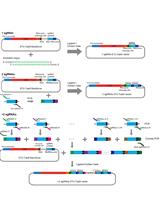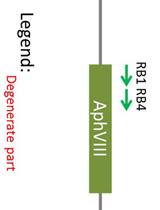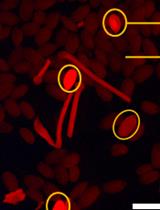- EN - English
- CN - 中文
High Resolution Melting Temperature Analysis to Identify CRISPR/Cas9 Mutants from Arabidopsis
高分辨率熔解温度分析鉴定拟南芥中的CRISPR/CAS9突变体
发布: 2018年07月20日第8卷第14期 DOI: 10.21769/BioProtoc.2944 浏览次数: 8859
评审: Rainer MelzerRunlai HangMarta Bjornson
Abstract
CRISPR/Cas9 made targeted mutagenesis and genome editing possible for many plant species. One of the ways that the endonuclease is used for plant genetics is the creation of loss-of-function mutants, which typically result from erroneous DNA repair through non-homologous end joining (NHEJ) pathway. The majority of erroneous repair events results in single-bp insertion or deletion. While single-bp insertions or deletions (indels) effectively destroy the function of protein-coding genes through frameshift, detection is difficult due to the small size shift. High-resolution melting temperature analysis allows quick detection, and it does not require any additional pipetting steps after the PCR amplification of the region of interest. In this protocol, we will describe the steps required for the analysis of potential homozygous mutants.
Keywords: CRISPR/Cas9 (CRISPR/Cas9)Background
CRISPR/Cas9 nuclease is a ribonucleoprotein that is capable of cleaving a DNA double strand at a specific 22 nucleotide sequence. The major advantage of the CRISPR/Cas9 system compared to other nucleases such as zinc-finger nucleases and Transcription Activator-Like Effector Nucleases (TALENs) is that the sequence specificity is conferred by the RNA and does not require separate proteins for each target sequence. This reduces the cost dramatically, and a single construct can target as many as 32 targets. Due to this low cost and efficiency, the CRISPR/Cas9 system is now widely used in many plant species (Baltes and Voytas, 2015; Belhaj et al., 2015).
When a double-stranded DNA break induced by CRISPR/Cas9 is erroneously repaired by the NHEJ pathway, the repaired sequence most frequently results in small indels, among which one bp indels are the most common (Ma et al., 2015; Pan et al., 2016; Ren et al., 2016). One bp indel is too small for a polyacrylamide gel electrophoresis-based method to detect, therefore alternative methods capable of detecting one-bp indels are needed (Zhu et al., 2014).
Currently, the most commonly used method for small indel detection takes advantage of enzymes such as T7 endonuclease (T7E1) and CEL nuclease that cleave mismatches (Yeung et al., 2005; Vouillot et al., 2015). In these methods, the region including the target sequence is amplified by PCR, followed by the melting-annealing cycle to generate heteroduplexes and digestion by the mismatch detecting enzymes. While these methods are very effective in detecting large indels, they are not very effective in detecting a one-bp deletion. Even with T7E1 nuclease, which is better suited for the detection of small indels compared to the CEL nuclease, the efficiency decreases as the indel size decreases (Gohlke et al., 1994).
An alternative method, high-resolution melting (HRM), offers multiple advantages. HRM detects a small shift in the melting temperature (e.g., caused by heteroduplexing) using a dsDNA-binding dye. Firstly, it does not require additional pipetting steps after the PCR amplification step of the target region. Secondly, the method reliably detects single bp indels at a low (5%) concentration. In this protocol, we describe the procedure to analyze the HRM curves of PCR fragments containing CRISPR-generated small indels (Denbow et al., 2017). Four steps required for the detection of CRISPR-induced indels in Arabidopsis include: i) genomic DNA extraction, ii) optimizing the PCR condition, iii) PCR step for analyzing either T1 plants or putative homozygous plants carrying a single bp deletion, and iv) data analysis.
Materials and Reagents
- Tissue disruption
- 2 ml microfuge tubes
- Glass beads, 4 mm diameter (Walter Stern, catalog number: 100E )
- Arabidopsis
- Liquid nitrogen
- 2 ml microfuge tubes
- DNA isolation
- 1.5 ml microfuge tubes
- Chloroform/IAA mixture (24:1)
- Isopropanol (CAS number 67-63-0)
- Ethanol (200 proof) (CAS number 64-17-5)
- 70% ethanol
- Tris-HCl (pH 7.5)
- Tris base (CAS number 77-86-1)
- EDTA free acid (CAS number 60-00-4)
- NaCl (CAS number 7647-14-5)
- CTAB (CAS number 57-09-0)
- RNase A (Sigma-Aldrich, catalog number: R6513 )
- Cesium Chloride (CsCl) (CAS number 7647-17-8)
- 2% CTAB solution (see Recipes)
- TE buffer (see Recipes)
- RNase A stock solution (see Recipes)
- 1 M CsCl solution (see Recipes)
- 1.5 ml microfuge tubes
- PCR
- Optical film (Bio-Rad Laboratories, catalog number: 2239444 )
- 96 well hard-shell black and white plate (Bio-Rad Laboratories, catalog number: hsp9665 )
- LC Green Plus (BioFire Defense, catalog number: BCHM-ASY-0006 )
- Phire Hot Start II DNA polymerase and buffer (Thermo Fisher Scientific, catalog number: F122 )
- dNTP, 100 mM each (Thermo Fisher Scientific, catalog number: 10297018 )
- Mineral oil (Fisher Scientific, catalog number: O121-1 )
- Agarose (CAS number 9012-36-6)
- PCR primers
- Glacial acetic acid (CAS number 64-19-7)
- TAE buffer (see Recipes)
Equipment
- LightScanner system (BioFire Defense, USA)
- PCR machine (Bio-Rad C1000) (Bio-Rad Laboratories, model: C1000 )
- Tissue grinder (Mini-Beadbeater-96, Biospec, OK, USA) (Bio Spec Products, model: Mini-Beadbeater-96 )
- Tabletop centrifuge (Eppendorf, model: 5427 R )
- Vortex mixer (Fisher Scientific, catalog number: 02-215-365 )
Software
- LightScanner software
Procedure
文章信息
版权信息
© 2018 The Authors; exclusive licensee Bio-protocol LLC.
如何引用
Denbow, C., Ehivet, S. C. and Okumoto, S. (2018). High Resolution Melting Temperature Analysis to Identify CRISPR/Cas9 Mutants from Arabidopsis. Bio-protocol 8(14): e2944. DOI: 10.21769/BioProtoc.2944.
分类
植物科学 > 植物分子生物学 > DNA > 诱/突变
分子生物学 > DNA > 诱/突变
您对这篇实验方法有问题吗?
在此处发布您的问题,我们将邀请本文作者来回答。同时,我们会将您的问题发布到Bio-protocol Exchange,以便寻求社区成员的帮助。
Share
Bluesky
X
Copy link













